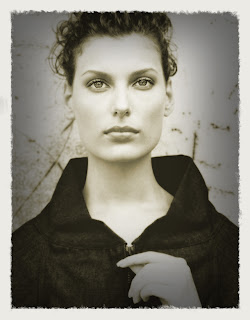Diane Arbus & Edward Steichen
Arbus' portraits are usually lit with direct flash mounted just off camera. She tends to let the background go black or at least be underexposed. In many of her photos the background is of little importance giving much more visual impact and focus to her subjects. Unlike the stylized, surreal, and ideal portraits of Steichen, Arbus produces thought provoking, quirky, and sometimes eerie photographs. The harsh lighting works quite well with her choice of subjects. They are quite often eccentric or odd looking looking people involved in humorous or ambiguous situations. Arbus consistently places her subjects in the center of the frame (in the case of two subjects they are spaced evenly giving a feeling of symmetry) and has them look right at the camera. The use of props demonstrated below further enhance and reinforce the quirky, eccentric air of her photos. I think her portraits are great because they show a completely different side of the subjects. An example of this is the drab "king and queen", a traditional symbol of wealth and power reduced to a rather pitiful representation of a motley couple. I find her photography, as depressing as it can be, is much like the work of Elliot Erwitt in terms of encompassing a great deal of humour in the frame.



Steichen's work, on the other hand, is extremely stylized. He uses very soft light in various patterns with the intention of beautification. I especially like use of side lighting. His subjects are mostly people who are famous or of some importance whereas Arbus' are unknown. The background in Steichen's photo's vary, though in many cases, unlike Arbus, they add an important element to the image. Like Arbus, Steichen frames his subjects mostly in the center, looking away from the lens. Rather than using props for humour, Steichen incorporates various items (such as the piano below) the enhance the composition and aesthetics. In the photograph below the curvature of the piano compliments the curvature of his subject while adding to the overall elegant tone of the image. His work is full of interesting use of shapes and space. I feel his photographs are successful as they instil a feeling of dreaminess with classic beauty and sophistication that just shouts "Hollywood". They are all quite surreal. They are very nice and easy to look at whereas Arbus' (equally great work) are more rough around the edges and have a completely different appeal.



Richard Avedon & Yousuf Karsh
Avedon's portraits have a very distinct style. They all use extremely soft lighting, a lot of butterfly. The model is usually posed in the center of the frame and framed 3/4 or head & shoulders. I noticed that many of his subjects are either very pale or have an abundance of freckles. This gives a nice visual quality. The background is pure white and of little importance as I feel like Avedon wanted to focus on the person and their story (fact or fiction). He fills most of his frames with the subject. One very apparent thing about Avedon's portraits is the use of a border. He shows the edges of the slide or film holder which is very nice as it contains the large white spaces. The photos are very bright and full of highlights while still containing a lot of nice detail. The strong contrast of blacks and whites gives his photos great visual impact. I like his use of props in some images very much as they provoke thought. Upon seeing the below image, I have to wonder "Who is this boy and why is he holding a rattlesnake? What does he do?"



Yousuf Karsh is famous for very classic portraiture of important people. Unlike Avedon's vogue approach to portraiture, Karsh captures his subjects within their environment. Props are often tools of their trade or an item that makes a statement about the person (Warhol & Picasso). The looks captured on the faces of his subjects say so much about them. The images are very sharp and detailed. The lighting varies throughout his portraits though it is consistently strong, giving defined shadows (the complete opposite of Avedon) I especially enjoy the pattern created in using two lights over the shoulders (Warhol). The framing varies from portrait to portrait depending on he environment and if any props are used. There are though, many headshots. I find Karsh's photos very successful as they really capture the essence of the subject.



Annie Leibovitz
In my research I found that a device used by Annie Leibovitz is similar to that which shows up in the work Diane Arbus. Her lighting technique is quite similar. She will often use direct, on or slightly off camera flash. Like Arbus, she underexposes the background by a couple of stops intentionally, though she does not let it fade to black. The background remains an apparent/important element affecting the mood of the photograph. Another similarity between the two photographers is that Leibovitz's work is also quite quirky (though it contains a high concentration of celebrities).

























